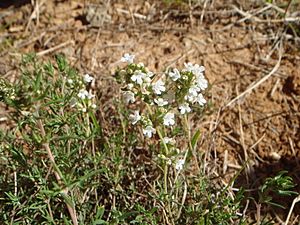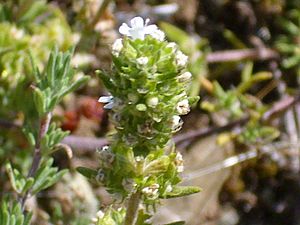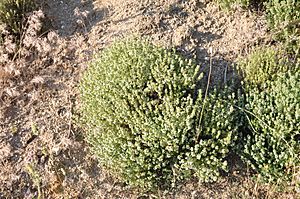Thymus zygis facts for kids
Quick facts for kids Thymus zygis |
|
|---|---|
 |
|
| Conservation status | |
| Scientific classification | |
| Genus: |
Thymus (plant)
|
| Species: |
zygis
|
| Subspecies | |
|
|
Thymus zygis is a type of flowering plant that belongs to the Lamiaceae family, which also includes mint. This plant naturally grows in the Iberian Peninsula (Spain and Portugal) and in northern Morocco. It is also known as Spanish thyme or white thyme.
Contents
What Thymus Zygis Looks Like
The leaves of Thymus zygis are thin. They are usually about 8 millimeters (about a third of an inch) long. This plant has small white flowers.
It grows best in sandy or loamy soils. Loamy soil is a mix of sand, silt, and clay. Thymus zygis can grow well even if the soil does not have many nutrients. It can also handle different soil conditions, from acidic to alkaline.
Where Thymus Zygis Grows
You can find Thymus zygis very often in the southern parts of Spain and Portugal. It also grows in Morocco.
How Thymus Zygis Reproduces
Thymus zygis is a gynodioecious plant. This means that some plants have flowers with both male and female parts. Other plants have flowers with only female parts. The number of female-only plants can be very different, ranging from 17% to 87% of the total plants. On average, about half of the plants are female-only.
This plant can also create new types of plants. It can mix with other Thymus species. This happens when different types of thyme flower at the same time.
Inside the cells of Thymus zygis, there are tiny structures called chromosomes. These carry the plant's genetic information. The number of chromosomes can be different among plants of this species. Their size is usually very small, about 1 to 2 micrometers.
Types of Thymus Zygis
There are different types of Thymus zygis, called subspecies.
T. zygis ssp. gracilis
This subspecies has 28 chromosomes in its cells. It grows in more places than the other two subspecies. It also grows more upright than the sylvestris subspecies.
T. zygis ssp. sylvestris
This subspecies has more chromosomes, either 56 or 58. It does not grow near the coast. Instead, it prefers cold and wet places. This is different from the other two types. This subspecies also has more tiny hairs on its leaves compared to the zygis subspecies.
T. zygis ssp. zygis
This subspecies has 28 chromosomes, just like gracilis.
How People Use Thymus Zygis
As Food
People use Thymus zygis as a food ingredient. In Spain and Portugal, it is collected from the wild. It is used as a dried or fresh herb. This plant is also popular to grow and mix with other thyme types. This is because it has many different smells and flavors. However, another type of thyme, Thymus vulgaris, is more commonly used for cooking.
For Essential Oils
Thymus zygis is mostly used to make essential oils. It is the main plant used for what we call thyme oil. Spain makes most of this essential oil. This is because Thymus zygis grows a lot in the Iberian Peninsula.
Three main areas in Spain produce thyme oil: Almería, Murcia, and Albacete. In 1989, about 25 tons of essential oil were made. From 1990 to 1998, this went up to 35 to 45 tons each year. People want more essential oils now, so even more is likely made today.
The best time to collect the plant for oil is when it is flowering. This gives the most oil. When the plant is resting, it gives the least oil. The oil's ingredients change depending on the plant's growth stage. The essential oils are stored in special glands on the plant.
The main ingredients in these essential oils are thymol, carvacrol, linalool, and p-cymene. The amount of each ingredient can be different. This is because there are different chemotypes (chemical types) of Thymus zygis. Each subspecies can have multiple chemotypes.
- gracilis subspecies: This type has two main chemotypes. One is rich in thymol (up to 68.1%). The other is rich in linalool (up to 82.3%). Oils from these chemotypes can stop or kill some types of bacteria. This means they could be used to keep food fresh naturally.
- sylvestris subspecies: This type has four main chemotypes. These include linalool (up to 30.0%), carvacrol (up to 25.0%), thymol (up to 23.8%), and geranyl acetate/geraniol. The thymol type is very common in Spain. Oils from this subspecies can fight certain fungi that cause skin problems. They also do not harm human cells at the amounts needed to fight fungi.
Thyme oil has many uses. It is found in perfumes and cosmetics. It also flavors chocolates, toothpaste, and mouthwash. You can even find it in cough medicine.
For Polyphenols
Thymus zygis contains special compounds called flavonoids. These are part of a larger group called polyphenols. Flavonoids help plants in many ways. In thyme, they have properties that protect against harmful substances called free radicals. This means they act as antioxidants.
Here are some polyphenols found in Thymus zygis and its subspecies:
- Thymus zygis (general)
- Apigenin
- Cirsimaritin
- Luteolin
- 6-OH-Luteolin
- Xanthomicrol
- Vicenin-2
- Thymus zygis ssp. sylvestris
- Cirsilineol
- 8-OMe-Cirsilineol
- Cirsimaritin
- 5-Desmethylnobiletin
- 5-Desmethylsinensetin
- Sideritoflavone
- Thymonin
- Thymusin
- Xanthomicrol
- Thymus zygis ssp. zygis
- Cirsilineol
- 8-OMe-Cirsilineol
- Cirsimaritin
- 5-Desmethylnobiletin
- 5-Desmethylsinensetin
- Sideritoflavone
- Thymonin
- Thymusin
- Xanthomicrol
Common Names for Thymus Zygis
In English, Thymus zygis is sometimes called Spanish thyme or white thyme. Since it grows mainly in Spain and Portugal, it has many names in other languages.
| Common names: | ajedrea (Spanish, Castillian), ajedrea menuda (Spanish, Castillian), ajedrea menuda española (Spanish, Castillian), almaradux salsero (Spanish, Castillian), almoradux de la tierra (Spanish, Castillian), almoraduz (Spanish, Castillian), común (Spanish, Castillian), escarqueja (Spanish, Castillian), farigola salsera (Catalan), ferrigola (Catalan), herba tioira (Galician), herba tioirera (Galician), herba tioura (Galician), jenjerina (Spanish, Castillian), mejorana (Spanish, Castillian), morquera (Spanish, Castillian), ouregâo do mato (Portuguese), paticas de mona (Spanish, Castillian), poexo (Galician), ratero (Spanish, Castillian), rosmarinho (Portuguese), salserilla (Spanish, Castillian), salsero (Spanish, Castillian), salseta de pastó (Aragonese), sanjuanes (Spanish, Castillian), señorida de flor blanca (Majorcan), sensero (Spanish, Castillian), serpâo-do-monte (Portuguese), serpol de peñas (Spanish, Castillian), sinserino (Spanish, Castillian), thymo de España (Spanish, Castillian), timonet (Catalan), timonet (Valencian), tioira (Galician), tombillo (Spanish, Castillian), tomilhinha (Portuguese), tomilho (Portuguese), tomilho vulgar (Portuguese), tomilleja (Spanish, Castillian), tomillina (Spanish, Castillian), tomillo (Spanish, Castillian), tomillo aceitunero (Aragonese), tomillo aceitunero (Spanish, Castillian), tomillo aceytunero (Spanish, Castillian), tomillo albar (Spanish, Castillian), tomillo ancinoso (Spanish, Castillian), tomillo ansero (Spanish, Castillian), tomillo áspero (Spanish, Castillian), tomillo basto (Spanish, Castillian), tomillo blanco (Spanish, Castillian), tomillo borriquero (Spanish, Castillian), tomillo de aceitunas (Spanish, Castillian), tomillo de flor morada (Spanish, Castillian), tomillo de flor rojiza (Spanish, Castillian), tomillo de las aceitunas (Spanish, Castillian), tomillo de las fustas (Spanish, Castillian), tomillo de San Juan (Spanish, Castillian), tomillo del campo (Spanish, Castillian), tomillo español (Spanish, Castillian), tomillo fino (Spanish, Castillian), tomillo lagartijero (Spanish, Castillian), tomillo macho (Spanish, Castillian), tomillo negrillo (Spanish, Castillian), tomillo negro (Spanish, Castillian), tomillo oloroso (Spanish, Castillian), tomillo piojoso (Spanish, Castillian), tomillo rastrero (Spanish, Castillian), tomillo risquero (Spanish, Castillian), tomillo rojo (Spanish, Castillian), tomillo salao (Spanish, Castillian), tomillo salsero (Aragonese), tomillo salsero (High Aragonese), tomillo salsero (Spanish, Castillian), tomillo salsero de Toledo (Spanish, Castillian), tomillo sanjuanero (Spanish, Castillian), tomillo sansero (Spanish, Castillian), tomillo sansero fino (Spanish, Castillian), tomillo serrillo (Spanish, Castillian), tomillo tanarro (Spanish, Castillian), tomillo terrero (Spanish, Castillian), tomillo terrestre (Spanish, Castillian), tomillo zaucero (Spanish, Castillian), tomillo zorrero (Spanish, Castillian), tremonsillo (Catalan), tremonsillo (Valencian), tumillo (Spanish, Castillian) |
See also
 In Spanish: Thymus zygis para niños
In Spanish: Thymus zygis para niños




